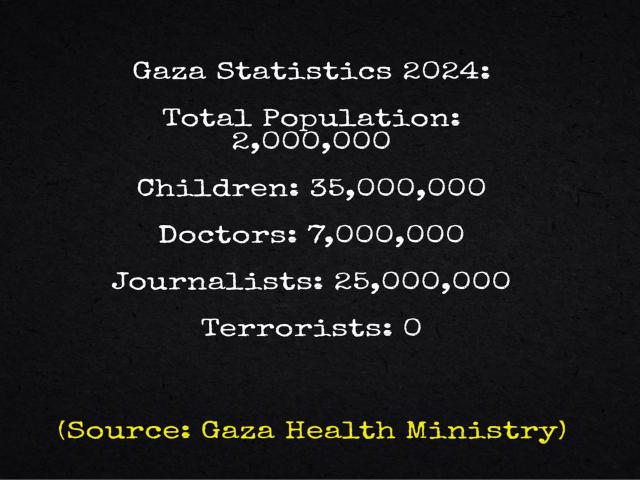Less than a month following the release of a critical report by the Washington Institute, which questioned the plausibility of Gaza's reported death toll statistics, the Hamas-controlled Ministry of Health in Gaza admitted to possessing "incomplete data" for a significant portion of the fatalities it claimed. Specifically, on April 6, the ministry revealed that it had incomplete information for 11,371 out of the 33,091 Palestinian fatalities it had documented. An individual's record was deemed incomplete if it lacked any of the essential data points: identity number, full name, date of birth, or date of death.
This admission followed an earlier acknowledgment on April 3, where the ministry noted the presence of incomplete data but failed to clarify what constituted "incomplete," initially citing 12,263 incomplete records. The reduction to 11,371 incomplete records within just three days remains unexplained, shedding light on more than 900 records somehow being updated or corrected.
Yet more evidence that Palestinian casualty figures issued by #Hamas-run Gaza Health Ministry are fabricated https://t.co/5SqSbkUdPu
— UK Lawyers For Israel (@UKLFI) April 9, 2024
Before this acknowledgment, the ministry had claimed that over 15,000 fatality records were derived from "reliable media sources," yet it never specified these sources. The absence of independent media in Gaza further complicates the credibility of these claims. This revelation casts a shadow over the ongoing debates regarding the fatality numbers from the Hamas-Israel conflict, which have often centered on the inability to differentiate between combatants and non-combatants. However, a deeper issue is now apparent: the very numbers themselves are increasingly unreliable.
During the initial phase of the conflict, the Ministry of Health in Gaza relied on its traditional system of hospitals and morgues to verify deaths. However, with the onset of the Israeli ground invasion in early November, the operational capacity of hospitals in northern Gaza was significantly compromised, leading to the adoption of an undefined new methodology for counting fatalities based on media reports. This shift has contributed to the majority of fatalities reported in the past four months, raising questions about the integrity of these figures.
David Adesnik, Senior Fellow and Director of Research at the Foundation For Defense of Democracies, criticized the sudden methodological shift, suggesting it indicates the ministry's desperation to mask its inadequate reporting practices. Adesnik highlighted how U.S. media, and even President Biden, had previously regarded the ministry's casualty figures as credible enough for regular updates on the conflict. This reliance is now questionable, given that a substantial portion of the ministry's data is, at best, incomplete and, at worst, entirely fictional.
.@adesnik: "The sudden shifts in the ministry’s reporting methods suggest it is scrambling to prevent exposure of its shoddy work. For months, U.S. media have taken for granted that the ministry’s top-line figure for casualties was reliable enough to include in daily updates on… https://t.co/qwZQ1joizL
— FDD (@FDD) April 9, 2024
The current conflict differs from previous ones in that neither OCHA (the UN Office for the Coordination of Humanitarian Affairs) nor various local and international NGOs are conducting real-time fatality verification efforts in Gaza. This absence, coupled with the limited operational capacity of Gaza's healthcare infrastructure and the significant access issues across the territory, severely undermines the ministry's new methodology for death counts, particularly outside the Rafah and Khan Yunis governorates.
On November 10, the ministry announced its inability to report deaths from two northern provinces, later admitting to relying on "reliable media sources" for such reports—a method apparently adopted as early as November 3. This methodological pivot was highlighted by a controversial incident involving a mid-October explosion at the Al Ahli Arab Hospital in northern Gaza, initially attributed to an Israeli airstrike by global media. Subsequent investigations revealed no evidence supporting this claim, with U.S. intelligence suggesting a Palestinian-fired rocket as the likely cause.
Last night, a failed rocket launch by the Islamic Jihad terror organization hit the Al Ahli hospital in Gaza.
— Eylon Levy (@EylonALevy) October 18, 2023
Here is video evidence from the Israeli Air Force system that captured the area before and after—on top of last night's live footage from Al Jazeera and security cams. pic.twitter.com/8cEgBgY6Zl
The Qatar-based Al Jazeera network, which had a live feed of the Gaza skyline actually picked up the errant rocket, which later was attributed to Palestinian Islamic Jihad. Despite the visual proof, the ministry has still not identified fatalities resulting from errant Palestinian rocket fire, despite the Israeli Defense Forces reporting that over 10 percent of rockets launched during the first month of the war fell inside Gaza.
Joe Truzman, a Senior Research Analyst at FDD's Long War Journal who has been documenting the conflict in realt time on his X feed, emphasized Hamas's vested interest in controlling the narrative regarding casualty figures in Gaza. This includes downplaying the number of terrorists killed by Israel, which could potentially exceed 10,000. News organizations attempting to estimate their own casualty figures face significant challenges due to the chaotic nature of the conflict and the damaged institutional infrastructure. The Hamas-run Ministry of Health's refusal to detail its data collection methods further complicates the reliability of the reported death toll, which heavily relies on media reports, accounting for more than 14,000 fatalities.
It's a miracle, the dead are rising again in Gaza.
— Eli Dror (@edrormba) April 9, 2024
Hamas Ministry Of health death toll is screwed up again#Gaza #HamasISIS #deathtoll 👇🤔😜 https://t.co/yNr6bGfaLZ
The Gaza Health Ministry's quiet admission of inaccuracies in its casualty figures signals a recognition of growing skepticism towards the reported numbers. The initial investigation by Gabriel Epstein of The Washington Institute's Koret Project on Arab-Israel Relations ignited this scrutiny, leading to a reluctant acknowledgment by Hamas. This attempt to correct the record, without offering specifics, continues to demonstrate Hamas's strategy of manipulating public sentiment by projecting inflated casualty figures, thus attempting to garner sympathy through the shock value of purportedly high death tolls.


